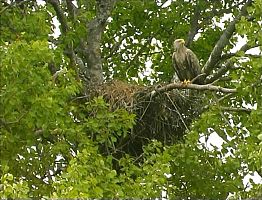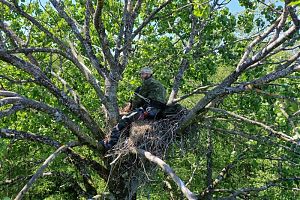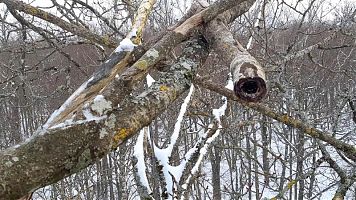White-tailed eagle nest camera 2023
29.03.2013 | Rubriik: Veebikaamerad
We have been following the white-tailed eagles in Matsalu National Park since 2021. This is one of the oldest known white-tailed eagle breeding territories in Estonia (the first reports date back to the 1870s (Sits, 1937)). The eagles built this nest in 1996 and it has been inhabited ever since. It is a very suitable nesting area for white-tailed eagles as there is also a second pair of eagles nesting less than a kilometer from this one. Between 1996 and 2020, a total of 30 eaglets have fledged from this nest.
24 nestlings out of 30 have been ringed here and as many as eleven of them have been seen later. An eaglet from 2012 was seen in front of the then white-tailed eagle webcam in Läänemaa in 2018 and an eaglet from 1995 visited the eagles winter feeding camera in 2012 and 2013, but that bird was found mortally injured only 10 km from the place of birth in 2019. The last eaglet in this nest was ringed in June 2020 and was seen in north-western Estonia at the beginning of February in 2022.
In 2021 there were two chicks, but both died of bird flu H5N1 in May (see here). The adults Eve and Eerik have not been seen since. In 2022 several eagles visited the nest, but there was no brood. By the end of the season we could see a couple forming. The male has rings M1215+E340 (ringed by Renno Nellis and Dr Madis Leivits in 2015), but the female is unringed. They were named Ella and Elmar by the camera viewers. Ella laid one egg on March 29th. The hatching is expected at the beginning of May (incubation period ~38 days). White-tailed eagle chicks usually fledge in early July and the young stay near the nest until September. Of course, if all goes well.
Livestream from the white-tailed eagle nest can be seen on Eagle Club Estonia’s YouTube channel https://www.youtube.com/Kotkaklubi.
-
 Vaade pesale 2002. aastal. Kaader filmist “Eesti kotkad” (Gaviafilm, 2005)
Vaade pesale 2002. aastal. Kaader filmist “Eesti kotkad” (Gaviafilm, 2005)
-
 Poja rõngastamine 2020. aastal. Foto: Kaarel Kaisel
Poja rõngastamine 2020. aastal. Foto: Kaarel Kaisel
-
 Kaamera pesalt vaadatuna. Objektiiv on peidetud haava oksa sisse.
Kaamera pesalt vaadatuna. Objektiiv on peidetud haava oksa sisse.
The nest camera was set up by Urmas Sellis (Eagle Club Estonia) and Omar Neiland (Beta Grupp OÜ). We use AXIS F41 camera with a custom-made microphone from Omar. The main body of the camera is below the nest on the tree trunk, but the lens and sensor are at the nest level. We tried to camouflage the camera as much as possible and hid it inside a dry aspen branch. Therefore, the camera remains relatively inconspicuous when seen from the nest. The camera is powered by solar panels. We transmit the camera image via 4G mobile internet, so in case of intensive network use, there may be interruptions in the transmission.
The camera is streamed through the Eagle Club Estonia’s YouTube channel. We recommend following Kotkaklubi channel in case the broadcast needs to be restarted due to technical errors, which may change the direct link of the broadcast. Kotkaklubi channel also feature all other nesting cameras of Estonian eagles and black storks, as well as a capercaillie camera.
The preparation and recording of the camera signal for streaming takes place with the support of Estonian Fund for Nature. Events in the nest are documented by the viewers in Looduskalender forum. The use of the stream from the nest for non-commercial purposes is not prohibited, but please let us know if possible (send a message to urmas(ät)kotkas.ee). Contributors are welcomed with each camera, as some components need to be replaced every year and we do not have any project support for hardware costs.
White-tailed eagle nest camera team and supporters:
Eagle Club Estonia – nest related actions, camera installation and information
Beta-Grupp OÜ – camera testing and setup, microphone construction, technical support
Looduskalender – forum on the Web
Estonian Fund for Nature – server support
Akukeskus Tartus – battery assistance
Several private donors – to cover unexpected and expected hardware costs
Thousands of viewers – the most important, because otherwise the cameras would not make much sense!




